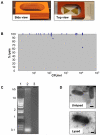Ultra-fast and sensitive detection of non-typhoidal Salmonella using microwave-accelerated metal-enhanced fluorescence ("MAMEF")
- PMID: 21494634
- PMCID: PMC3073000
- DOI: 10.1371/journal.pone.0018700
Ultra-fast and sensitive detection of non-typhoidal Salmonella using microwave-accelerated metal-enhanced fluorescence ("MAMEF")
Abstract
Certain serovars of Salmonella enterica subsp. enterica cause invasive disease (e.g., enteric fever, bacteremia, septicemia, meningitis, etc.) in humans and constitute a global public health problem. A rapid, sensitive diagnostic test is needed to allow prompt initiation of therapy in individual patients and for measuring disease burden at the population level. An innovative and promising new rapid diagnostic technique is microwave-accelerated metal-enhanced fluorescence (MAMEF). We have adapted this assay platform to detect the chromosomal oriC locus common to all Salmonella enterica subsp. enterica serovars. We have shown efficient lysis of biologically relevant concentrations of Salmonella spp. suspended in bacteriological media using microwave-induced lysis. Following lysis and DNA release, as little as 1 CFU of Salmonella in 1 ml of medium can be detected in <30 seconds. Furthermore the assay is sensitive and specific: it can detect oriC from Salmonella serovars Typhi, Paratyphi A, Paratyphi B, Paratyphi C, Typhimurium, Enteritidis and Choleraesuis but does not detect Escherichia coli, Pseudomonas aeruginosa, Klebsiella pneumoniae, Streptococcus pneumoniae, Haemophilus influenzae or Acinetobacter baumanii. We have also performed preliminary experiments using a synthetic Salmonella oriC oligonucleotide suspended in whole human blood and observed rapid detection when the sample was diluted 1:1 with PBS. These pre-clinical data encourage progress to the next step to detect Salmonella in blood (and other ordinarily sterile, clinically relevant body fluids).
Conflict of interest statement
Figures





Similar articles
-
Genetic determinants and polymorphisms specific for human-adapted serovars of Salmonella enterica that cause enteric fever.J Clin Microbiol. 2006 Jun;44(6):2007-18. doi: 10.1128/JCM.02630-05. J Clin Microbiol. 2006. PMID: 16757591 Free PMC article.
-
Novel Heptaplex PCR-Based Diagnostics for Enteric Fever Caused by Typhoidal Salmonella Serovars and Its Applicability in Clinical Blood Culture.J Microbiol Biotechnol. 2023 Nov 28;33(11):1457-1466. doi: 10.4014/jmb.2307.07031. Epub 2023 Aug 21. J Microbiol Biotechnol. 2023. PMID: 37674393 Free PMC article.
-
Adaptation of red blood cell lysis represents a fundamental breakthrough that improves the sensitivity of Salmonella detection in blood.J Appl Microbiol. 2015 May;118(5):1199-209. doi: 10.1111/jam.12769. Epub 2015 Mar 12. J Appl Microbiol. 2015. PMID: 25630831 Free PMC article.
-
Clinical pathogenesis of typhoid fever.J Infect Dev Ctries. 2008 Aug 30;2(4):260-6. doi: 10.3855/jidc.219. J Infect Dev Ctries. 2008. PMID: 19741286 Review.
-
Comparative accuracy of typhoid diagnostic tools: A Bayesian latent-class network analysis.PLoS Negl Trop Dis. 2019 May 8;13(5):e0007303. doi: 10.1371/journal.pntd.0007303. eCollection 2019 May. PLoS Negl Trop Dis. 2019. PMID: 31067228 Free PMC article.
Cited by
-
Relationship between antibody susceptibility and lipopolysaccharide O-antigen characteristics of invasive and gastrointestinal nontyphoidal Salmonellae isolates from Kenya.PLoS Negl Trop Dis. 2015 Mar 4;9(3):e0003573. doi: 10.1371/journal.pntd.0003573. eCollection 2015 Mar. PLoS Negl Trop Dis. 2015. PMID: 25739091 Free PMC article.
-
Microwave-accelerated method for ultra-rapid extraction of Neisseria gonorrhoeae DNA for downstream detection.Anal Biochem. 2016 Oct 1;510:33-40. doi: 10.1016/j.ab.2016.06.017. Epub 2016 Jun 17. Anal Biochem. 2016. PMID: 27325503 Free PMC article.
-
Applications of Microwave Energy in Medicine.Biosensors (Basel). 2021 Mar 26;11(4):96. doi: 10.3390/bios11040096. Biosensors (Basel). 2021. PMID: 33810335 Free PMC article. Review.
-
Rapid sample preparation with Lyse-It® for Listeria monocytogenes and Vibrio cholerae.PLoS One. 2018 Jul 25;13(7):e0201070. doi: 10.1371/journal.pone.0201070. eCollection 2018. PLoS One. 2018. PMID: 30044836 Free PMC article.
-
Sensitive detection and serovar differentiation of typhoidal and nontyphoidal Salmonella enterica species using 16S rRNA Gene PCR coupled with high-resolution melt analysis.J Mol Diagn. 2014 Mar;16(2):261-6. doi: 10.1016/j.jmoldx.2013.10.011. Epub 2013 Dec 21. J Mol Diagn. 2014. PMID: 24365382 Free PMC article.
References
-
- Levine MM. Typhoid Fever Vaccines. In: Plotkin SA, Orenstein WA, editors. Vaccines. Philadelphia: Saunders; 2004. pp. 1057–1093.
-
- Voetsch AC, Van Gilder TJ, Angulo FJ, Farley MM, Shallow S, et al. FoodNet estimate of the burden of illness caused by nontyphoidal Salmonella infections in the United States. Clin Infect Dis. 2004;38(Suppl 3):S127–S134. - PubMed
-
- Vugia DJ, Samuel M, Farley MM, Marcus R, Shiferaw B, et al. Invasive Salmonella infections in the United States, FoodNet, 1996–1999: incidence, serotype distribution, and outcome. Clin Infect Dis. 2004;38(Suppl 3):S149–S156. - PubMed
-
- Kennedy M, Villar R, Vugia DJ, Rabatsky-Ehr T, Farley MM, et al. Hospitalizations and deaths due to Salmonella infections, FoodNet, 1996–1999. Clin Infect Dis. 2004;38(Suppl 3):S142–S148. - PubMed
Publication types
MeSH terms
Substances
Grants and funding
LinkOut - more resources
Full Text Sources
Other Literature Sources
Medical
Miscellaneous

